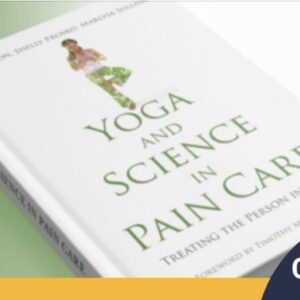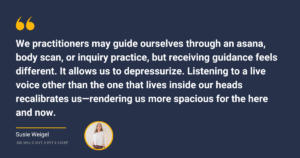The body doesn’t live in the past or the future—it lives in NOW—so if we tune into it, we’re here.
– Michael Lee, Ch.11 Embodia Course
Living in the present
By: Susie Weigel, MS, MEd, C-IAYT, E-RYT & YACEP
This principle (living in the present) — the marrow of Michael Lee’s message and the underlying principle of his Phoenix Rising Yoga Therapy methodology — found me with impeccable timing. I prefer simplicity to complexity, quiet to cacophony. Yet lately I find myself so muddled by what has been done and what is yet to be done that my noisy, complicated preoccupation with past and future renders me stagnant.
I am a Yoga Therapist in need of Yoga Therapy.
This need became increasingly clear to me as I reflected on “Transforming Psycho-Emotional Pain,” Lee’s chapter in Yoga and Science in Pain Care, and its corresponding online course. While the chapter is compelling, the online course is profound. It illuminates the chapter’s message with an experience that brought my body into NOW with mystifying simplicity. In a 20-minute chair yoga therapy practice, Michael Lee helped guide me back to myself. It was refreshing to feel the methodology the chapter outlines.
The experience makes it real—it breathes life into the principles.
I often get so wrapped up in the quality of what I need to offer that I lose sight of what I need to practice. We practitioners may guide ourselves through an asana, body scan, or inquiry practice, but receiving guidance feels different. It allows us to depressurize. Listening to a live voice other than the one that lives inside our heads recalibrates us—rendering us more spacious for the here and now. The practice offered in the Chapter 11 course, Transforming Psycho-Emotional Pain, punctuates the importance of this.
Patanjali’s eight-limbed path
It embodies the transformational process described in the chapter which is a modernized yoga therapy-style application of Patanjali’s eight-limbed path through a bottom-up approach:
- Move & Breathe (synchronized simple, intentional, and energetic movement and breathwork)
- Stretch & Hold (variation of tense and release)
- Notice & Meditate (body scan and meditation)
- Inquire & Integrate (ask your body, listen, trust its answer and apply it)
The simple but remarkable practice and discussion touches on themes that characterize Phoenix Rising’s approach:
- Befriending Your Body
- Awareness
- Acceptance
- Choice
- Discerning Choices
- Truth
- Skillful Truth in Action
- Flow (inspired by Mihaly Csikszentmihalyi)
Befriending your body, being present now in your body is the necessary first step.
Top-down or bottom-up?
In my own yoga therapy training, there was discussion of top-down or bottom-up approaches and how to discern what the best entry point might be for a particular yoga therapy client.
For Michael Lee, when it comes to transforming psycho-emotional pain, the body is the quintessential entry point because it is our vessel for present-moment awareness. It often takes time and utmost care to foster this friendship toward our bodies, especially when trauma is involved.
But it is possible.
It may start with noticing a subtle pleasant sensation in the body even when pain or aversion is present elsewhere. This may facilitate a shift in body awareness that allows a different perspective to emerge.
As Lee points out, for some, the perspective shift arises from a life-changing event that doesn’t involve yoga at all (like the “Overview Effect” experienced by some astronauts after they view Earth from space, or the experience of profound loss and grief).
But many of us simply become bogged down by the multitudinous bumps in the road as we travel life’s path. It’s as if the repetition of those bumps causes concussion-like symptoms over time—obscured vision, achiness, loss of present-moment awareness, confusion—for the head and the heart.
The bottom-up approach recommended by Lee guides us back to heart-centered awareness. From there, fogginess gives way to clearer vision, truth, and insight. From there, we can begin to act in alignment with our heart’s wisdom.
Our work as yoga therapists is to facilitate this homecoming. In partnership with clients, we provide experiential learning that fosters recalibration and connection.
Connection
Connection. Sometimes the stars align and multiple synchronicities emphasize a situation that might otherwise seem meaningless.
When this happens, the universe is trying to get our attention.
Prior to writing this blog, for example, I was overwhelmed with some life changes—a new job and shifts in family dynamics—and feared I wouldn’t find time to complete the task I signed up for several months prior. I am averse to tardiness, but I had to ask for extra time. As it turned out, my later re-reads of the chapter and experience of the course occurred when I was better able to process and experience Lee’s message.
The bottom-up practice helped get me out of my head and into my body, and I was able to sense into my heart. I sensed both disquiet (uncomfortable, staticky, and more apparent) and faith (comforting and warm but less apparent). For now, it’s information that I’m revisiting. I haven’t yet skillfully put my heart’s wisdom into action. But I’m working on it.
As Lee cautions, it takes time. And distractions are a normal part of the process. Sometimes they help the process. I was lost in thought while walking recently when a pair of pileated woodpeckers flew overhead, landed in nearby trees, and began pecking away.
This startled me out of my head and beautifully into now.
Brief, unexpected, perspective-shifting, awe-inspiring, and inquiry-worthy. “Working on it” doesn’t require laborious yoga practice, but it does require engaging in yoga as a way of life. As we become increasingly dependent on technology and less present in our bodies, it is important to connect to our physicality and breath: walking, gardening, spending time in nature, or any activity that engages the body and connects us now is a good place to start.
This is the 11th blog post in a series based on the Yoga and Science in Pain Care Book Club, a 15-part course based on the book of the same title, by Neil Pearson, Shelly Prosko, and Marlysa Sullivan. You can find the blogs corresponding to Chapter 1, Chapter 2, Chapter 3, Chapter 4, Chapter 5, Chapter 6, Chapter 7, Chapter 8, Chapter 9 and Chapter 10.
References:
- Pearson, N., Prosko, S., Sullivan, M. (2019) Yoga and Science in Pain Care: Treating the Person in Pain. Jessica Kingsley Publishers.
- Yoga and Science. In Pain Care: Chapter 11 online course Feb 2021. Embodia.
—
Date published: 10 April 2024
Last update: 5 April 2024



